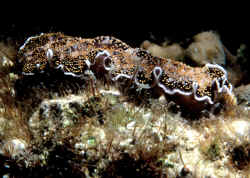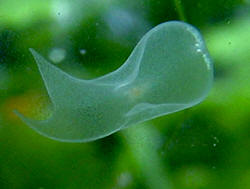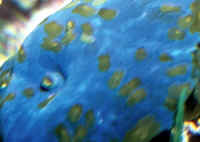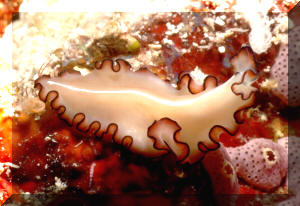|
Related FAQs; Flatworms/Planaria 1, Flatworms 2, Flatworms 3, & FAQs on: Flatworm Identification, Flatworm ID 2, Flatworm ID 3, Flatworm Behavior, Flatworm Compatibility, Flatworm Control, Predator Control, Chemical Control, Flatworm Selection, Flatworm Systems, Flatworm Feeding, Flatworm Disease, Flatworm Reproduction,
Related Articles: Pest Flatworm Control by Anthony
Calfo, Worm Diversity, The
Flatworms That Are Flukes by Bob Fenner
/The Conscientious Reef
Aquarist:
Flatworms, including
"Planaria" & Marine Aquariums, Part
1
To: Part 2, Part 3, Part 4,
Part 5, Part 6
|

|
|
By Bob Fenner
|
Thysanozoon nigropapillosum
|
Of the worms, the Platyhelminthes ("flat worms") are
considered the prototypes, having developed such innovations as
bilateral symmetry, a head, tail, and three germinal tissue layers
(stinging celled animals, comb-jellies... only have two). These simple
soft-bodied animals use their skin to breath through and only have one
body opening, the mouth serving also as an anus.
The Flatworm Phylum includes two groups of
well-known parasitic species of aquatic animals; the Tapeworms (Class
Cestoda) and Flukes (Class Trematoda). These are important species to
humans directly and indirectly through their negative interactions with
food and ornamental animal life, including fishes. There are many
species of both Cestodes and trematodes that live on/in fishes and
their gill cavities. Fortunately, due to complex life histories and
careful quarantine, dips/baths, most aquarists don't come in
contact with these parasitic forms.
The free-living (i.e. non-parasitic) species of
Flatworms, the Class Turbellaria are more of note... True, some of them
do trend toward being pests when their numbers get out of control...
and can be problematical should you provoke a poisonous variety to the
point of toxin release... most are benign organisms that are best
ignored. Most of us have had contact at High School science classes
with the tiny freshwater genus Planaria. These are the remarkable worms
that you cut in two and witnessed regeneration with.
Class Turbellaria: Mostly free-living Flatworms; about 3,000
described species.
Acoel Flatworms: Simple, "gut-less", small worms...
including the ones that "reproduce like rabbits" in reef
tanks... best left alone... or selectively siphoned off (mainly) soft
corals, out of reef systems.
| Amphiscolops sp., a harmless Acoel
that "shows up" at times in reef tanks. Photo by Mike
Giangrasso |

|
| Does this look like fun to you? Here's an
infestation of Acoel flatworms (perhaps Convolutriloba
retrogemma) on someone's (Birch Aquarium, San Diego,
California, USA) Corallimorphs... Best to... leave them alone,
siphon off, seek a predator? |

|
| Waminoa sp. 1 Characterized by having a
pumpkin silhouette appearance and a yellow dot at the base of their
caudal notch (and a lack of other unknown members of the genus
other coloring, marking characteristics...). Overall color due to
algal symbionts (Dinoflagellates, diatoms?). Think you've seen
infestations? Here are some images made in the Lembeh Strait in N.
Sulawesi. Below: on Bubble Coral (Plerogyra),
Goniopora (Flower Pot Coral) and a Fungiid (Heliofungia
actiniformes). |
Polyclad Flatworms: Referring to their multi-branched
digestive system. Similar to Nudibranchs, but lacking the latter's
"naked gills"; flatworms are "flatter", and often
much faster moving.
| Bulaceros sp. Transparent w/ a broken white line,
random dark spots on body. To 20 cm. The genus is cryptic; but here seen
feeding on a star during the day in S. Leyte 2013. |
%20MD.jpg)
|
Bigger PIX:
The images in this table are linked
to large (desktop size) copies. Click on "framed" images
to go to the larger size. |
|
%20MD.JPG)
|
Genus Maiazoon:
| Maiozoon orsaki Newman & Cannon 1996.
Creamy colored body, ruffled margin, with a thin white line down
its back, skirted by black and burgundy edging. Raja Ampat
08. |

|
To: Part 2, Part 3, Part 4,
Part 5, Part 6

